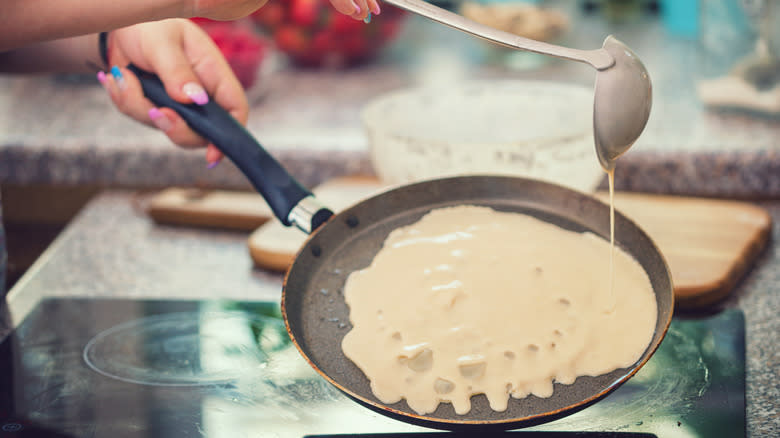Strain Your Batter For Smoother Homemade Crepes

Whether you're a fan of Nutella and banana flavors or more savory versions, crepes are one of morning's best -- and most versatile -- breakfasts. Making your own crepes can be as simple or as intricate as you'd like, though no matter your preferred toppings, don't forget one crucial step. In general, it's best to strain your crepe batter before you add any heat, which will enhance the texture of your finished breakfast.
In fact, straining crepe batter is important because it rids your food of any potential lumps. When you originally mix together a crepe batter, flour may create clumps, which are best removed via straining. Generally, you'll want to aim for a thin, smooth crepe batter, perfect for rolled-up crepes.
As for how, exactly, to strain your batter, the process requires little extra effort on the part of the home chef. Simply grab a sieve or strainer, and incorporate one extra step to your favorite crepe recipe. Running your mixed batter through a sieve will smooth it out and remove pesky air pockets, so your end product -- a warm, smooth crepe -- both looks and tastes cohesive.
Read more: 25 Most Popular Snacks In America Ranked Worst To Best
Strain Your Crepe Batter And Let It Rest Before Turning On The Stove

Making crepes seems simple, but it's a process where the little steps -- and attention to details -- add up. As such, it's best to strain your crepes immediately after your batter is completed, before you commence any cooking. To do so, run your batter through a sieve, which will catch any unnecessary clumps. If you don't have a sieve, you can instead use a metal strainer or cheesecloth; any straining appliance will do the job. And, luckily, sieves are multi-purpose for bakers, so you can also use your strainer to sift flour across baking recipes.
This straining rule pertains to all kinds of crepes. So, even if you're making pineapple dulce de leche crepes -- a dessert as much as they are a breakfast -- try straining before cooking your batter. You'll notice the difference in texture.
Once you strain your crepes, you then have a few options for finishing your recipe. If you're big on patience, it's ideal to give your strained, smoothed batter a few hours to rest before you add any heat. This timeframe can span one to 24 hours, though it's not entirely necessary. Whether you leave your mixture in the bowl or start pouring immediately, your crepes will taste delicious. That is, so long as you strain your batter first.
Read the original article on Tasting Table.


